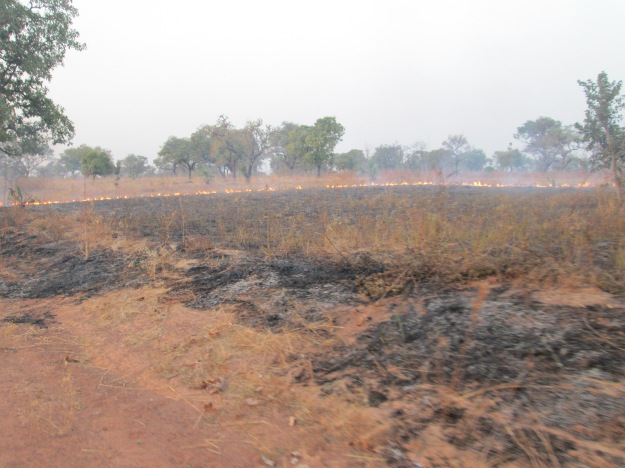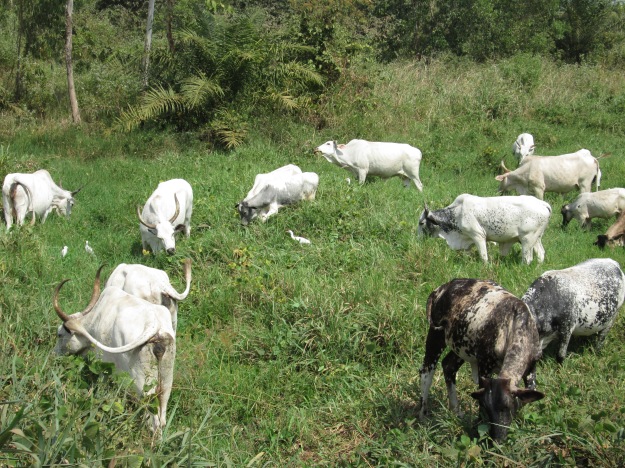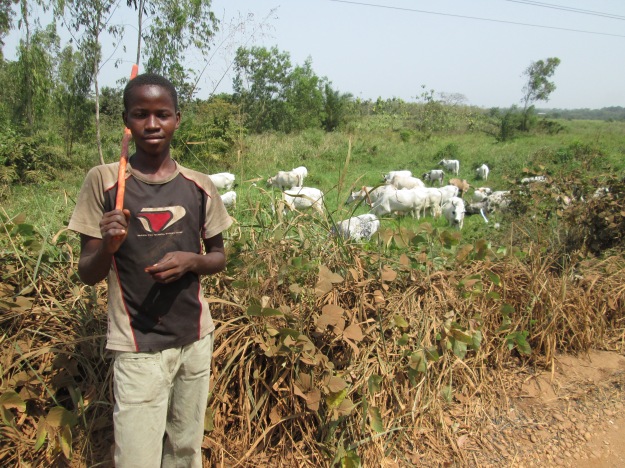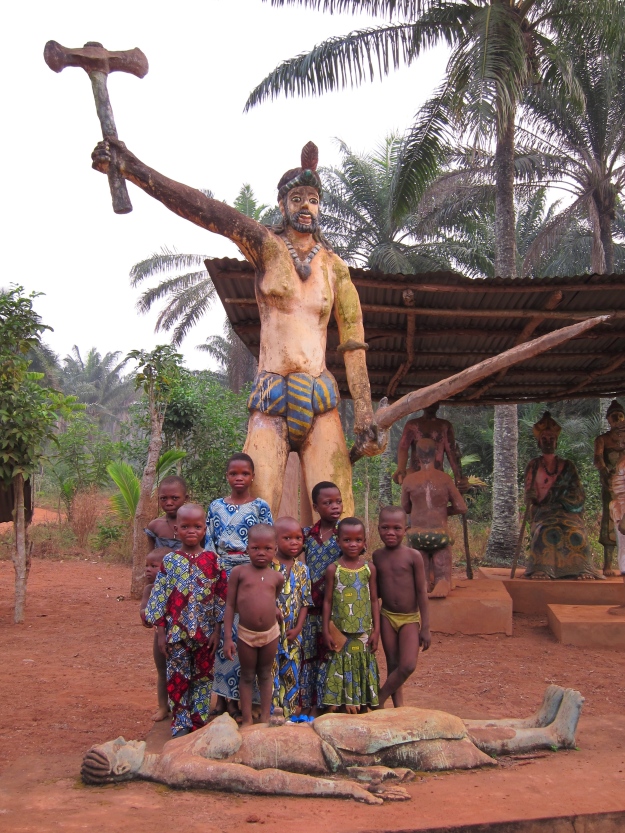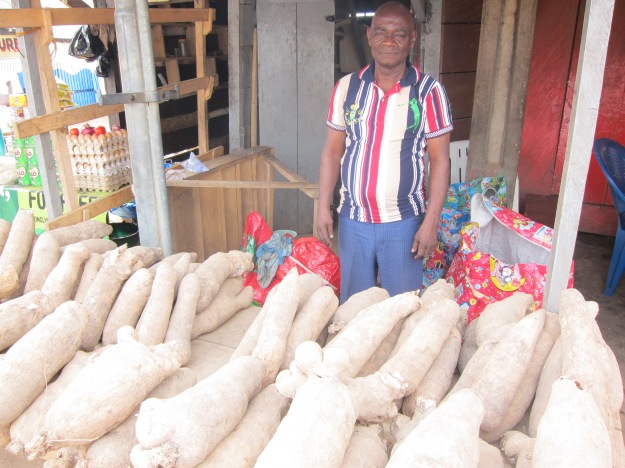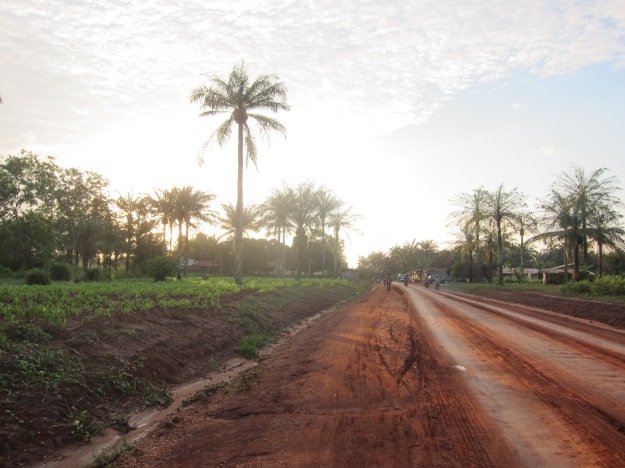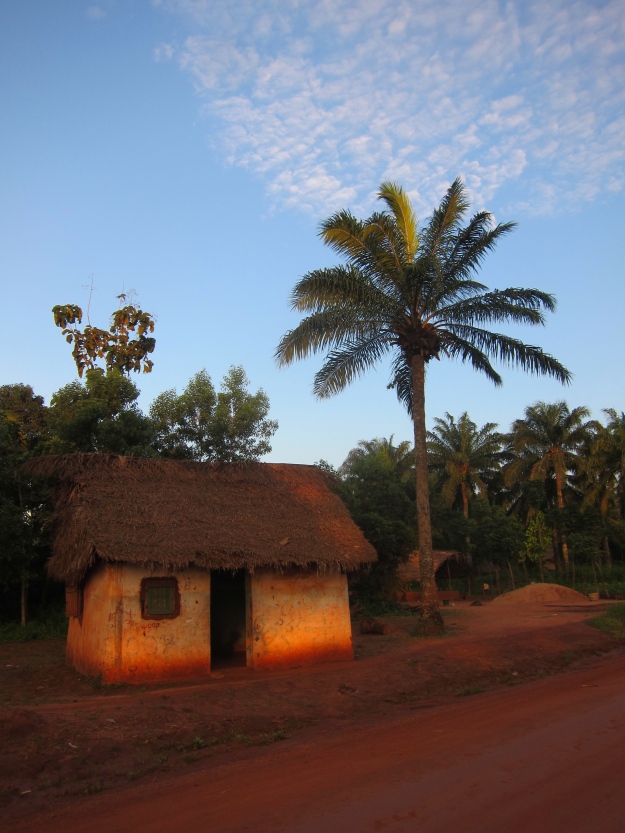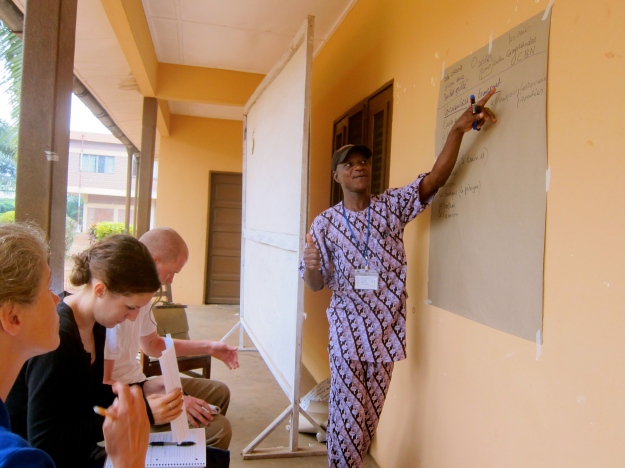Cotton is, economically, Benin’s most important crop, making up 40% of GDP.
Tag Archives: agriculture
Pineapple Fields Forever
Central southern Benin grows a lot of pineapples. Lack of infrastructure and industrial processing plants prevents most of the pineapples from being exported. Instead, pineapples flood the market. I have gotten spoiled by the abundance of cheap, delicious pineapples that are usually sold for 75 – 100 cfa ($0.15 – $0.20) each. This is a field of pineapple plants. Each plant grows one pineapple.
Hèvioso: Divinity of Thunder and Revenge
Statues and monuments of Vodun divinities abound in our town, frequently to protect a house from evil spirits, a family from illness or a field from bandits. Most are small and simple. Some, like this statue of the divinity of thunder and revenge, show complex scenes with ten-foot tall statues. It was explained to me that Hèvioso can protect you from directed harm and will then take revenge on the person who sought to harm you. The scene in the photo above apparently shows Hèvioso killing a woman who tried to poison another person. Note the small bottle of poison resting on her stomach. The photo below also shows Hèvioso; this statue is a neighboring town.
Yams (Not Sweet Potatoes)
Yams are more commonly eaten (and grown) in northern Benin as opposed to the south where we live. Different than what we refer to as a yam in the US, yams here are enormous, starchy tubers similar to manioc. Yams can be huge — some thicker than my thigh and longer than my arm. They are commonly eaten fried or mashed. Yum.
Sacred Forest

Most forests in our area have been cut down to make room for agriculture but small pockets have been preserved because of their religious importance. One such ‘sacred forest’ is just a fifteen minute walk from our house though we didn’t know this until recently when a local friend brought us and told us the history of the area. This is the largest tree in this patch of forest and, according to people in our town, the largest and oldest tree in southeastern Benin.
Hello, New Neighbors!
Since I posted this, Peace Corps has changed the location of the CED training site, so the new trainees won’t be living so close by. I hope you still enjoy the tour of our town!
Over the past few weeks Peace Corps has been sending letters of invitation to the next cohort of Benin trainees, who will start their service this July. It just so happens that Adam and I live in the town where the Community Economic Development program will hold training, so we’re going to have about a dozen American neighbors for our last few months in Benin!
In the months leading up to our departure from the States, I had so many questions and no idea what to expect, and it stunk! Family and friends were all asking me perfectly reasonable questions for which I had no answers. Where would I live? Would I have electricity? Internet access? Telephone? Not only did I feel like a broken record saying “We’ll have to wait and see” over and over, but I was really curious about the very basics.
To give the new people an idea of where they’re headed (and hopefully to entertain the rest of you readers who want to know more about where Adam and I live), this post is a tour of our town. I don’t know about any host family arrangements or specific training sites, but at least I can give an idea of life in our town.
I’m not supposed to put the name of our site on our blog, but I can say that it’s a town of about 20,000 people on the outskirts of Porto Novo (nope, not that one). It’s the chef ville d’arrondissement—basically, the county seat—so it’s the center of the action. Still, there’s not a whole ton of stuff to do besides ride bikes or relax at a buvette (open-air bar). Our town doesn’t have any internet cafes, but trainees can get their own cellphones shortly after arriving in country, and can find time to go out and buy a USB internet key within a few weeks. (It’s also a great activity for practicing French!)
Two local languages are spoken here. Gun predominates in the center of town. Studying Fon is helpful preparation for speaking Gun, though it’s not exactly the same. In the rural outskirts people speak Tɔli. It’s hit or miss whether people speak French, but there’s almost always someone around to translate. Catholicism, Celestial Christianity, and Vodun are the predominant religions here, and there are also several mosques.

Celestial Christian churches are small and numerous. And the kids running over to get a peek at me are pretty typical, too.
Our town has a market day every fourth day. (If you hold out your hand with fingers outstretched, your thumb and pinky are the market days.) We have a big market, so you can get almost everything here—tomatoes, greens, onions, ginger, garlic, salt, pepper, fish, crabs, fabric, clothing, flip-flops, pineapples, oranges, bananas, avocados, sweet potatoes, oatmeal, powdered milk, couscous, pasta, eggs, soap, cosmetics, beads, jewelry, Vodun necessities, fried dough balls, palm oil, peanut oil, flour, sugar, baskets, batteries, pens, bungee cords, bike inner tubes, cigarettes, cats, chickens, manicures, hair extensions (DIY or full service), and on and on. For things like chocolate, coffee, “French vegetables” (carrots, cabbage, eggplant, lettuce), and foreign condiments (soy sauce, mustard, fish sauce), you have to go to a supermarket in Porto Novo. At the Porto Novo supermarkets you can also buy cheese, ice cream, American candy, cereal, and pretty good wine, but these will break your budget if you buy them often.

This is a typical market stall. Other women–and kids–walk around selling things from trays balanced on top of their heads.
The market is hectic, loud, and crowded, but it’s not huge, and you can learn your way around in one visit. Once you make friends with a few sellers, marketing gets to be a little more fun and social, and you don’t have to work as hard to obtain reasonable prices. If you forget that it’s market day, you’ll be reminded by the thick stream of bicycles and motos heading through town heavily loaded with livestock. Some of the fixed storefronts in town close down on market day, while others put additional merchandise on display. On off-days, the market area has a few sellers with the very basics.

Most of the sellers at the market are women, but this is the bike guy. He’s really nice and he’s got all the stuff you need to keep your bike rolling smoothly.
The route connecting Porto Novo with the Nigerian border cuts right through the center of town, so it’s easy to flag down a zemi (taxi moto) to visit trainees from the other program sectors (Rural Community Health, Teaching English as a Foreign Language, Environmental Action). The ride to any of these places costs less than $0.75, which is easily affordable on the living allowance you get during training. If you like to cycle, you could also bike to any of the other training sites within a half hour. Trainees all get bikes as soon as they go to live with their host families (after about three days in country).
Once you get away from the main road, our town quickly transitions into a rural landscape of cows, goats, oil palms, corn, manioc, peanuts, and Vodun shrines. Agriculture is the main occupation here, and the fringes of town are green, quiet, and calm. In contrast to the crazy motorcycles and busy commerce of the town center, the activity out here consists of people hoeing, herding, and chopping. There is a fairly dense network of large roads, so you’re never too far from a direct route back into the center of town and it’s hard to get truly lost. But you can also pretty easily feel like you’re in the middle of nowhere.

There are many wetland areas throughout our region, and the water is only a few kilometers away from the center of town… a good destination for an early morning run.
Traffic on our town’s central road is hectic in the morning, with hordes of taxis and trucks heading between Nigeria and Porto Novo and on to Cotonou. It quiets down during the midday heat while everyone rests indoors. Then at night, the place comes back to life. Crossing the road during the evening rush could take you a solid ten minutes. A bit later, things mellow out a bit and the carrefour repopulates as stalls open up selling grilled meat, fruit, beans, corn, and fried dough.
People drive in on their motos and gather in clusters to shoot the breeze. There are a couple of TV stalls where people watch soap operas. Or you can sit at a table in the town park and drink a beer.

It’s usually men who are out relaxing at night and the women who are selling food at the stands, but I get away with going out with Adam.
It’s easy to find something to eat from a street vendor as long as you look at the right time. Between the hours of 9 am and 1 pm, and then from 5 pm on, you can find vanzu with gari or a plate of pâte (blanc/corn or noir/yam) or akassa (rice and bean mixture) with sauce (de legume or de tomate), fried plantains, eggs, or fish. We have a bakery that cranks out baguettes at all hours. Women sell the bread right in front of the bakery and walk around town selling it from baskets balanced on their heads. With your bread you can get delicious fish-based or tomato-based spreads, smashed avocado and onion mixture, or margarine. We also have a few spaghetti omelet stands. Any of these meals will run you about one dollar. Most Peace Corps Volunteers avoid the local specialty, an okra-and-leafy-green-based sauce called krin-krin which has the consistency of thin rubber cement (to put it delicately).

A spaghetti omelet is a plate of spaghetti topped with scrambled egg mixed with onion and hot pepper. A side of bread is optional.
Recently the food scene in our town got a million times better with the opening of a FanMilk depot. I’m gonna go there and say it’s the best snack Benin has to offer—due in no small part to the fact that it’s frozen.
Trainees live with host families, which is mostly wonderful though sometimes awkward. Households around here are organized in big fenced compounds called concessions. Some concessions have groups of apartments rented by unrelated families, and some are home to family groups. Some have a single house, some have multiple standalone structures, and some have a row of apartment blocks. Buildings range from mud-brick single-room structures to complicated mansions with tiled façades. Concessions might be enclosed by cinder block walls and metal gates, or they might have a live tree fence with an entrance gap. If there’s no running water, the concession will have a well. In my opinion, the nicest concession features are payotes (thatched gazebos) and shade trees. Concession yards are bare dirt, and keeping their yards and street fronts swept clean is a constant chore for the little girls in the household.
Host families tend to be among the more well-to-do members of the community, so during training you might find yourself living more comfortably than the typical Peace Corps stereotype would have you imagine. (It’s a crap shoot whether that holds after training, but volunteers tend to have the upper end of conditions wherever they are.) Peace Corps requires that trainees have a private bedroom with a locking door and screened windows, and they provide a table and chair, mosquito net, water filter, locking trunk to store valuables, and some other little goodies to help you get settled. Electricity is the norm in our town center, and running water is common but certainly not a given. When Adam and I stayed in town briefly for our site visit, our bedroom opened onto a breezy balcony and we had our own private bathroom with a flushing toilet and running water. Our family was fantastic, so I have my fingers crossed that they will be hosting a new trainee!
Peace Corps changes the training program every year partly in response to feedback from volunteers and mandates from Washington, and I am not involved in training so I don’t have much information about this year’s plans. (In fact, this is the first year trainees will be staying in our town.) So take this with a grain of salt! Last year we attended training on Monday through Friday from 9 to 5, with a half-day on Saturday. The first part of training focused on language, with occasional sessions on health, safety and security, and culture. Language classes were small—two to five people—and they were held at a classmate’s house (a fun way to get to know other host families) or a central location, depending on our group’s choice. The last month of training focused on technical content.
The other sessions were held at a central location with trainees from all the sectors together. Training includes presentations, field trips, group work, and a little trial by fire. To me, the culture sessions were the best part of training. We had a fashion show, a demonstration of uses for all sorts of Beninese items from the market (such twigs for cleaning teeth, herbs, homemade laundry soap), an iron chef competition, and a session on music and dance. I liked these sessions because they were more casual and they gave me a chance to practice language in an interesting and applied setting.
Hope that gives you some idea of what you’re heading into. See you all soon!!


